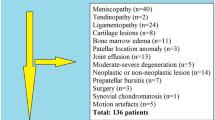Abstract
Objectives
To assess the reliability of patellotrochlear Index (PTI) in patellar height assessment on successive MRI scans in asymptomatic patients.
Materials and methods
Sixty-four patients with two successive MRI scans (128 studies) of the same knee for non-patellofemoral joint symptoms were identified retrospectively. PTI and knee flexion angle were assessed independently by three observers to assess interobserver reliability. The effect of knee flexion on PTI was assessed by comparing the change in values of PTI in each patient correlated with change in knee flexion.
Results
Sixty-four MRIs of patients (M:F) aged between 18 and 35 years (mean 24.6) years were assessed. The mean PTI for initial scan group was 0.33% (95% CI: 0.29–0.37; SD: 0.15) and consecutive scan group was 0.30% (CI: 0.27–0.33; SD: 0.3). The difference was not significant (p = 0.097 using a paired t test) with high inter-observer correlation (0.9) in both sets. Spearman’s rho for knee flexion angle and PTI was found to be positive and statistically significant (0.41; p = 0.001). A linear regression model was derived using a scatter chart of change in PTI with change in knee flexion for each patient. The gradient of the linear regression line was used to estimate a cPTI (corrected PTI) value (corrected to 0 degrees of knee flexion), defined as cPTI = PTI – 1.3a (a = knee flexion angle).
Conclusions
This study demonstrates high inter-observer correlation of PTI on MRI and high test–retest reliability indicating unconscious quadriceps contraction does not change the index sufficiently. Knee flexion significantly alters PTI, increased patellotrochlear engagement with flexion increases the index. We propose use of the formula cPTI = PTI -1.3a to correct the index to 0 degree knee flexion in clinical practice.





Similar content being viewed by others
References
Ali SA, Helmer R, Terk MR. Patella Alta: lack of correlation between patellotrochlear cartilage congruence and commonly used patellar height ratios. AJR. 2009;193:1361–6.
MJ AL-S, Cameron JC. Functional outcome after tibial tubercle transfer for the painful patella alta. Clin Orthop. 2002;396:152–62.
Karadimas JE, Piscopakis N, Syrmalis L. Patella alta and chondromalacia. Int Orthop. 1981;5:247–9.
Dejour H, Walch G, Nove-Josserand L, Guier C. Factors of patellar instability: an anatomic-radiographic study. Knee Surg Sports Traumatol Arthrosc. 1994;2(1):19–26.
Monk AP, Doll HA, Gibbons CL, Ostlere S, Beard DJ, Gill HS, et al. The pathoanatomy of patellofemoral subluxation. J Bone Joint Surg (Br). 2011;93(10):1341–7.
Biedert RM, Albrecht S. The patella-trochlear index: a new index for assessing patellar height. Knee Surg SportsTraumatol Arthrosc. 2006;14(8):707–12.
Kobayashi S, Pappas E, Fransen M, Refshauge K, Simic M. The prevalence of patellofemoral osteoarthritis: a systematic review and meta-analysis. Osteoarthr Cartil. 2016;24(10):1697–707.
Staubli HU, Bosshard C, Porcellini B, Rauschning W. Magnetic resonance imaging for articular cartilage: cartilage-bone mismatch. Clin Sports Med. 2002;21:1.
Van Huyssteen AL, Hendrix MRG, Barnett AJ, Wakeley CJ, Eldridge JDJ. Cartilage-bone mismatch in the dysplastic trochlea—an MRI study. J Bone Joint Surg (Br). 2006;81-B:688–91.
Caton J, Deschamps G, Chambat P, Lerat JL, Dejour H. Patella-infera. Apropos of 128 cases. Rev Chir Orthop Reparatrice Appar Mot. 1982;68(5):317–25.
Insall J, Salvati E. Patella position in the normal knee joint. Radiology. 1971;101(1):101–4.
Grelsamer RP, Meadows S. The modified Insall-Salvati ratio for assessment of patellar height. Clin Orthop Relat Res. 1992;282:170–6.
Blackburne JS, Peel TE. A new method of measuring patellar height. J Bone Joint Surg (Br). 1977;59(2):241–2.
Miller TT, Staron RB, Feldman F. Patellar height on sagittal MR imaging of the knee. AJR Am J Roentgenol. 1996;167(2):339–41.
Shabshin N, Schweitzer ME, Morrison WB, Parker L. MRI criteria for patella Alta and Baja. Skelet Radiol. 2004;33(8):445–50. https://doi.org/10.1007/s00256-004-0794-6.
Seil R, Muller B, Georg T, Kohn D, Rupp S. Reliability and interobserver variability in radiological patella height ratios. Knee Surg Sports Traumatol Arthrosc. 2000;8:231–6.
Becher C, Fleischer B, Rase M, et al. Effects of upright weight bearing and the knee flexion angle on patellofemoral indices using magnetic resonance imaging in patients with patellofemoral instability. Knee Surg Sports Traumatol Arthrosc. 2017;25(8):2405–13. https://doi.org/10.1007/s00167-015-3829-8.
Grelsamer RP, Proctor CS, Bazos AN. Evaluation of patellar shape in the sagittal plane. A clinical analysis. Am J Sports Med. 1994;22:61–6.
Barnett AJ, Prentice M, Mandalia V, Wakeley CJ, Eldridge JD. Patellar height measurement in trochlear dysplasia. Knee Surg Sports Traumatol Arthrosc. 2009;17(12):1412–5.
Camathias C, Pagenstert G, Stutz U, Barg A, Muller-Gerbl M, Nowakowski AM. The effect of knee flexion and rotation on the tibial tuberosity–trochlear groove distance. Knee Surg Sports Traumatol Arthrosc. 2015. https://doi.org/10.1007/s00167-015-3508.
Acknowledgements
The authors acknowledge the help of Mr. Roman Wesolowski and Mr. Robert Flintham, Clinical Scientists, Department of Medical Physics and Mr. Callum Smith, Department of Imaging, in conducting part of this study.
Author information
Authors and Affiliations
Corresponding author
Ethics declarations
Conflict of interest
The authors declare that they have no conflict of interest.
Ethical approval
The authors confirm this work complies with ethical principles regarding content of work. All procedures performed in studies involving human participants were in accordance with the ethical standards of the institutional and/or national research committee and with the 1964 Helsinki Declaration and its later amendments or comparable ethical standards.
Rights and permissions
About this article
Cite this article
Ahmad, M., Janardhan, S., Amerasekera, S. et al. Reliability of patellotrochlear index in patellar height assessment on MRI—correction for variation due to change in knee flexion. Skeletal Radiol 48, 387–393 (2019). https://doi.org/10.1007/s00256-018-3040-3
Received:
Revised:
Accepted:
Published:
Issue Date:
DOI: https://doi.org/10.1007/s00256-018-3040-3




